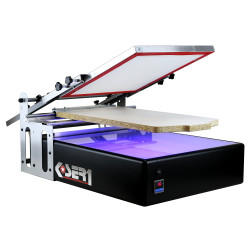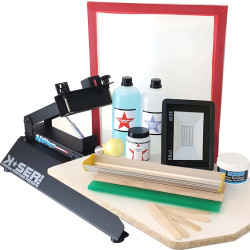Screen printing transfer is a fundamental technique for customizing fabrics with precision, durability, and creativity. In this article, we will explore everything you need to know about monochromatic A3 screen printing transfer, a method that combines finesse and flexibility. Whether you're a beginner or a professional, discover how this technique can transform your textile creations.
Article Index
- What is screen printing transfer?
- Why choose monochromatic A3 screen printing transfer?
- What materials are needed to create a transfer?
- How does the screen printing transfer process work?
- The advantages of screen printing transfer over other techniques.
- Steps to create a monochromatic A3 screen printing transfer.
- Screen printing transfer and textile customization: Best tips.
- The role of inks and transfer paper.
- Differences between screen printing transfer and digital transfer.
- Tips to ensure wash resistance and long-lasting quality.
What is screen printing transfer?
WATCH THE VIDEO: Transfer Application on Cotton
Screen printing transfer is a textile customization technique that uses transfer paper printed with special inks. This paper is then transferred onto fabric using a heat press, ensuring a precise and long-lasting result.
This method allows working on all types of fabrics, including cotton, polyester, or blended materials, and creating complex designs or multicolor prints.
Why choose monochromatic A3 screen printing transfer?
The monochromatic A3 screen printing transfer is perfect for creations requiring high finesse and a uniform result. The A3 format provides enough space for elaborate designs, and the monochromatic technique ensures sharp printing without gradients.
Advantages:
- Flexibility: Ideal for small to medium runs.
- Precision: Reproduces fine details, even down to a minimum fineness of 2 dots.
- Durability: Offers excellent wash resistance.
How to Choose the Perfect Transfer
Here’s a comparison table of the main types of screen printing transfers available on the market:
| Transfer Type | Best Fabric | Wash Resistance | Average Price |
|---|---|---|---|
| Water-based transfer | Light cotton | 30+ washes at 30°C | €0.35/unit |
| Plastisol transfer | Cotton/Polyester | 50+ washes at 40°C | €0.55/unit |
| Glow-in-the-dark transfer | All fabrics | 25 washes | €0.75/unit |
Screen Printing Transfer Prices: 2024 Comparison
If you're looking for screen printing transfers for small runs (50-100 pieces), our starter kits include everything you need, with savings of up to 30% compared to bulk purchases.

Result after 20 washes at 40°C (plastisol transfer)
Transfers for Heavy Cotton: 3 Solutions Compared
For heavy fabrics (300g and above), we recommend:
- HD Flex Transfer - Maximum elasticity
- UltraCoton Transfer - Optimal penetration
- ProWeight Transfer - For thicknesses over 400g
Where to Buy Screen Printing Transfers in Italy?
KeyGadgets.eu offers shipping in 24/48h across Italy for orders over €150. Contact us for information on customized products.
Frequently Asked Questions
❓ Which transfer should I use for black shirts?
Opt for an opaque transfer with a white underbase, ideal for ensuring coverage without transparency.
❓ How many transfers are needed for 100 shirts?
Depends on the design:
- Monochrome printing: ~105 transfers (5% waste)
- 4-color printing: ~120 transfers
What materials are needed to create a transfer?
To create a screen printing transfer, here’s what you’ll need:
- Screen printing frames suitable for your design.
- Screen printing inks, such as Plastisol, known for their adhesion and quality.
- Transfer paper to transfer the design onto the fabric.
- A heat press to apply the design onto the fabric.
This unique printing process requires precise tools to ensure a professional result.
How does the screen printing transfer process work?
The screen printing transfer involves printing a design onto paper backing before transferring it onto fabric. Unlike digital transfer, this method allows for highly detailed finishes.
Key Steps:
- Create the design after pre-press treatment.
- Print the design onto transfer paper using special inks.
- Apply the heated paper onto the fabric using a professional press.
The advantages of screen printing transfer over other techniques
Screen printing transfer stands out from methods like sublimation or DTF due to its versatility and durability.
Comparison:
- Traditional screen printing: Suitable for large runs but lacks flexibility.
- Digital transfer: Fast, but offers less wash resistance.
- Screen printing transfer: Combines the advantages of both, allowing customization of all fabric types with excellent durability.
Steps to create a monochromatic A3 screen printing transfer
Here’s how to make a monochromatic A3 screen printing transfer:
- Frame preparation: Expose your design with a verified file to avoid fineness issues.
- Printing on transfer paper: Use proper ink coverage for optimal results.
- Heat application onto fabric: Position the paper and apply even pressure with a heat press.
Screen printing transfer and textile customization: Best tips
Screen printing transfer allows customization of clothing, accessories, or sports equipment. For a perfect result:
- Ensure the ink is completely dry before transferring.
- Adjust your heat press temperature based on the fabric type.
- Avoid color issues by using a Pantone Solid Coated reference.
The role of inks and transfer paper
Screen printing inks are at the heart of the process. They ensure:
- High quality and detail precision.
- Wash resistance, even after multiple machine washes.
The transfer paper, on the other hand, plays a crucial role in preserving the design’s integrity before application.
Differences between screen printing transfer and digital transfer
Screen printing transfer offers several advantages over digital transfer:
- Durability: Longer-lasting thanks to special plastisol inks.
- Versatility: Works on a wide range of materials, including dark fabrics.
- Fineness: No borders required, unlike other techniques.
Tips to ensure wash resistance and long-lasting quality
To ensure your transfers maintain their wash resistance:
- Use high-quality inks.
- Apply a finishing treatment.






